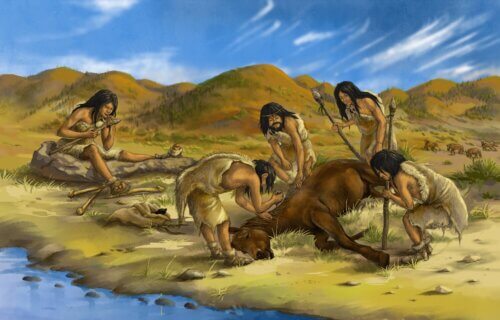BEIJING, China — Early humans in East Asia were developing advanced tools tens of thousands of years ago. The findings come from a detailed examination of artifacts from the Shiyu site in Shanxi Province, China. Specifically, the new discovery from roughly 45,000 years ago marks the earliest evidence of modern human activity in this part of the world.
“Our new study identified an Initial Upper Paleolithic archaeological assemblage from the Shiyu site of North China dating to 45,000 years ago that includes blade technology, tanged and hafted projectile points, long-distance obsidian transfer, and the use of a perforated graphite disk,” says study first author Yang Shixia, professor and researcher at the Institute of Vertebrate Paleontology and Paleoanthropology (IVPP) of the Chinese Academy of Sciences (CAS), in a university release.

The discovery at Shiyu offers valuable insights into the migration patterns and technological capabilities of Homo sapiens in East Asia around 45,000 years ago. In addition to the impressive toolkit, the site also yielded a human cranial bone, now lost, that contributes to understanding early human presence in the region.
Radiocarbon dating of three animal bone samples from the original 1963 excavation confirmed human modification, with cut marks indicative of tool use. These samples helped to date the main cultural layer of Shiyu to between 43,200 and 45,800 years ago.

The comprehensive scientific analysis of the Shiyu artifacts uncovered a rich array of advanced material culture from this period. This includes Levallois points – a distinctive type of stone tool production, hafted projectile points with evidence of use in hunting, obsidian obtained from sources hundreds of kilometers away, and intricately crafted bone points.
Taphonomic analysis, which examines how organisms decay and become fossilized, of mammal fossils at Shiyu, along with use-wear analysis of the stone tools, suggests that the site’s inhabitants were adept at hunting, particularly targeting adult horses. This specialization is evidenced by their specialized hunting tools.
The variety of tools found at Shiyu, from end-scrapers and awls to Levallois points and other tanged tools, highlights a rich and diverse culture. The long-distance transport of obsidian suggests advanced resource procurement strategies and significant migration abilities.

This discovery at Shiyu represents a blend of cultural creolization, a process where inherited cultural traits merge with new innovations. This blending complicates the traditional understanding of Homo sapiens’ global expansion, indicating a more complex and interconnected prehistoric world than previously thought.
The study is published in the journal Nature Ecology & Evolution.
Tracing The Journey Of Early Humans
Researchers believe the story of early human settlers in East Asia is a saga of resilience, innovation, and adaptation. The earliest human presence in East Asia can be traced back to Homo erectus, known for their remarkable journey out of Africa.
By about 1.8 million years ago, these early humans had ventured into what is now China and Indonesia. The famous “Peking Man,” discovered near Beijing, is a testament to their far-reaching migration.
As time progressed, these early humans gave way to modern Homo sapiens, who brought with them a burst of cultural and technological innovation. Excavations across East Asia have unearthed artifacts that reveal a rich tapestry of early human life – from cave paintings to the remains of sophisticated urban centers.

if they dig a little deeper they will find a Bridgeport….